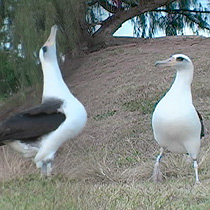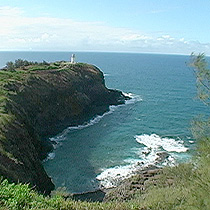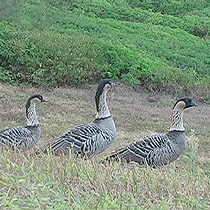-
(单词翻译:双击或拖选)
Kauai, Hawaii
22 June 2007
Seabirds such as albatross, shearwaters and boobies are extraordinary animals that live at sea for most of their lives. They fly great distances and seldom come to land to remind us that they still exist. Little is known about them, except that they are on the way to extinction1. Producer Zulima Palacio visited the remote Hawaiian island of Kauai, home to one of the seabirds' last habitats. Melinda Smith narrates2 the story.
 |
| The courtship ritual of the Laysan albatross |
Once a year, seabirds come to land for two reasons: to mate and to nest one egg. Just one chick a year. If anything happens to the chick, its parents go back out to sea and stay there until the following year. For the last several decades, the populations of many seabirds have been in rapid decline.
Brenda Zaun is the wildlife biologist for the U.S. Fish and Wildlife Service at the Kauai National Wildlife Refuge.
"Kauai itself has probably 70 to 80 percent of all Newell's shearwater in the world, nest on this island,” says Zaun. “Sometimes it is the last piece of habitat for a lot of these species that are getting close to extinction and so we really need to protect them and give them a safe habitat to nest in."
Zaun works in one of the most beautiful places of Hawaii. The U.S. established the National Wildlife Refuge at Kilauea Point in 1985 for the preservation3 of seabirds, green turtles and monk4 seals, as well as the island's historic lighthouse. Several species of seabirds have made a long strip of cliffs one of their last habitats in the Pacific.
Zaun says the efforts to recover the birds' diminished populations are starting to pay off with the growth of some species. But it is not easy. She says for the last 200 years, humans have introduced many animals to the islands that prey5 on the seabirds. Park rangers6 have fenced off the refuge, and they also have set traps for cats and rats. But the problem continues.
 |
| The Hawaiian island of Kauai |
"Last year, it was June 30th, it was just before 14 chicks were ready to fledge, ready to leave the island and go to sea, dogs came in and killed all 14 of them," Zaun recalls.
Zaun keeps count of many of the birds that come to the refuge. She tags many as chicks, such as baby albatrosses. But some come as adults and Zaun has devised ways to capture them.
Besides the albatross, other species also are close to extinction. Zaun says that back in the 1950s, Hawaiian geese, better known as nene, were down to less than 40 animals.
"People drive in and one of the first things they see are Hawaiian geese, and you can take them for granted because here they are all over the place, but really, we estimate there is only 16 or 1700 left in the world. They are that endangered."
Newell's shearwater are not only endangered, they are difficult to study and monitor. They only come to land after dark and head back out to sea before sunrise. One pair has been nesting in an accessible place in the refuge for three years now.
"Until we started putting up this equipment and monitoring just this two pair we didn't really know much about their reproductive behavior. We didn't even know what their incubation was," explains Zaun. She has installed cameras and electronic monitoring systems.
"I have taken several photographs of a cat looking in this burrow," she points out.
 |
| Hawaiian geese, or nene, are close to extinction at 40 animals |
Because of the birds' nocturnal comings and goings, most people never see them, except perhaps after they have crashed into power lines and other man-made objects. Some survive at a recovery treatment facility at Kauai Humane7 Society.
| Nick Holmes, Kauai's coordinator for recovery of endangered seabirds |
"If you look at the wings, they are quite long and quite narrow. This is what allows the bird to glide10, and allows the bird to travel such long distances at sea," says Holmes.
Back at the refuge, Brenda Zaun continues her watch over the seabirds. The Kauai National Wildlife Refuge closes its doors to tourists by late afternoon. By then it is time for the birds to return and feed their chicks or start another courtship ritual. This is Zaun's happiest time.
"My favorite time of the day is dawn and sunset when the wildlife is really out. In the evening, the nene comes and roost in here. It's a very different place at night," says Zaun.
 收听单词发音
收听单词发音
1
extinction

|
|
| n.熄灭,消亡,消灭,灭绝,绝种 | |
参考例句: |
|
|
|
2
narrates

|
|
| v.故事( narrate的第三人称单数 ) | |
参考例句: |
|
|
|
3
preservation

|
|
| n.保护,维护,保存,保留,保持 | |
参考例句: |
|
|
|
4
monk

|
|
| n.和尚,僧侣,修道士 | |
参考例句: |
|
|
|
5
prey

|
|
| n.被掠食者,牺牲者,掠食;v.捕食,掠夺,折磨 | |
参考例句: |
|
|
|
6
rangers

|
|
| 护林者( ranger的名词复数 ); 突击队员 | |
参考例句: |
|
|
|
7
humane

|
|
| adj.人道的,富有同情心的 | |
参考例句: |
|
|
|
8
coordinator

|
|
| n.协调人 | |
参考例句: |
|
|
|
9
remarkable

|
|
| adj.显著的,异常的,非凡的,值得注意的 | |
参考例句: |
|
|
|
10
glide

|
|
| n./v.溜,滑行;(时间)消逝 | |
参考例句: |
|
|
|















